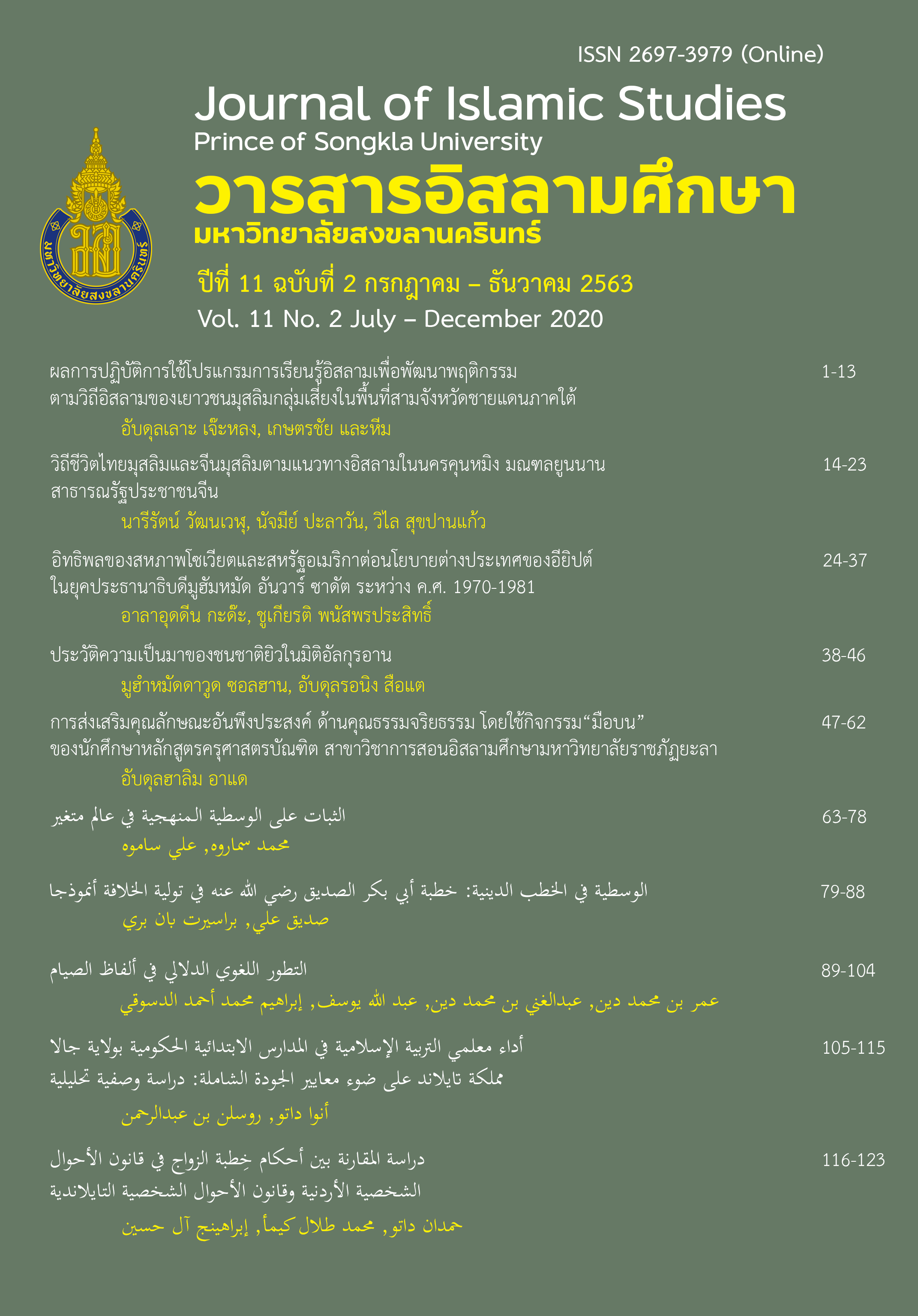ประวัติความเป็นมาของชนชาติยิวในมิติอัลกุรอาน
คำสำคัญ:
การอรรถาธิบาย, ความสัมพันธ์, บนีอิสรออีล, นบีนูห์บทคัดย่อ
การวิจัยนี้เป็นการวิจัยเชิงเอกสาร (Documentary Research) โดยเน้นการศึกษาแนวทางและการอรรถาธิบาย อายะฮฺที่: 3 จากซูเราะฮฺอัลอิสรออฺ ของบรรดาอุละมาอ์มุสลิมีนในอดีต และข้อมูลที่ปรากฏในคัมภีร์ โตราห์และคัมภีร์ใบเบิล และประวัติศาสตร์ (Historical Research) โดยใช้วิธีการพรรณนาวิเคราะห์ (Analytical Description) ในการนำเสนอผลการศึกษา
จากการศึกษาพบว่า:
- บนีอิสรออีล คือ วงศ์วานของอิสรออีล ผู้ที่สืบทอดเชื้อสายเผ่าพันธุ์ของผู้ที่เอกองค์อัลลอฮฺ / ได้บรรทุกไว้ในเรือกับนบีนูห์ ' ซึ่งไม่ใช่เชื้อสายจากนบีนูห์ '
- การอรรถาธิบายของบรรดาอุละมาอ์มุสลิมีนในอดีต คือ:
Mujahid bin Jabr - และ Al-Thawriy - กล่าวว่า: (ذرية من حملنا مع نوح) ความว่า: “โอ้ เผ่าพันธุ์ของผู้ที่เราได้บรรทุก (ไว้ในเรือ) กับนูห์เอ๋ย” พวกเขาคือ บนีอิสรออีล และ คนอื่นอีกด้วย
Ibnu A’adil กล่าวว่า: บางกลุ่มจะอ่านว่า “ซุรริยะตุ” (ذرية من حملنا مع نوح) หมายถึง พวกเขา คือ เผ่าพันธุ์ของผู้ที่เราได้บรรทุก (ไว้ในเรือ) กับนูห์
Al-Suyutiy กล่าวว่า: (ذرية من حملنا مع نوح) ความว่า: “โอ้ เผ่าพันธุ์ของผู้ที่เราได้บรรทุก (ไว้ในเรือ) กับนูห์เอ๋ย” การอ่านว่า “ซุรริยะตะ” (ذرية من حملنا مع نوح) หมายถึง โอ้ เผ่าพันธุ์ของผู้ที่เราได้บรรทุก (ไว้ในเรือ) กับนูห์เอ๋ย
- คัมภีร์โตราห์ (ปฐมกาล 11:10-26, 25:19-26, 32:22-27, 32:28, และ 35:23-26) คือ แหล่งที่มาของทัศนะที่เห็นว่า “ยิว” อ้างถึงบุตรของจาคอบที่มีชื่อว่า “ยูดาห์” และจาคอบ คือ อิสราเอล ดังนั้น บนีอิสราเอล คือ วงศ์วานจาคอบ ซึ่งมีเชื้อสายจากนบีอิบรอฮีม ' เป็นต้นตระกูล
ดังนั้น ชนชาติยิวคือผู้สืบวงศ์วานว่านเครือเผ่าพันธุ์ของผู้ที่พระเจ้าเอกองค์อัลลอฮฺ/ ได้บรรทุกไว้ในเรือกับนบีนูห์ ' และ อิสราเอล ก็ไม่ใช่นบียะอฺกูบ ' ที่มีเชื้อสายจากนบีอิบรอฮีม ' เป็นต้นตระกูล
คำสำคัญ: การอรรถาธิบาย ความสัมพันธ์ บนีอิสรออีล นบีนูห์ '
เอกสารอ้างอิง
Al-A’ainiy, Badruddin. (2016). U’uwmdatuh Al-Qariy syarh Sashih Al-Bukhariy ( عمدة القاري شرح صحيح البخاري). Lebanon: Dar Al-kutub Al-Ilmiyah.
Al-Albaniy, Muhammad Nasiruddiy. (n.d). วงศ์วานของอิสรออีลและทัศนะที่เกี่ยวข้อง” สืบค้นวันที่ 23/3/2016 จาก http://www.arabiandna.com/vb/showthread.php?t=5350
Al-Naisaburiy, Abu Abdulloh Al-Hakim. (1997). Al-Mustadrak A’la Assahihain ( المستدرك على الصحيحين). Lebanon: Dar Al-kutub Al-Ilmiyah.
Al-Thawriy, Sufyan Ibn Masrouq Al-Thawriy. (1983). Tafsir Al-Thawriy (تفسير الثوري). Lebanon: Dar Al-kutub Al - Ilmiyah.
Al-Thabariy, Muhammad Ibn Jarir Al-Thabariy. (n.d). Jami‘u al-bayan fi t’awil ay al-Qur’an (جامع البيان في تأويل آي القرآن). Lebanon: Dar al-ma’aarif.
Al-Suyutiy, ‘Abdurrahman Ibn Abi Bakr. (2004). Al-Itqan fi ‘Ulum Al-Quran (الإتقان في علوم القرآن). Beirut: Dar Al-kitab Al-arabiy.
Arabicbible, (n.d). Pharisees, Essenes และ Sadducees. สืบค้นวันที่ 25/3/2016 จาก
https://ar.arabicbible.com/islam/faq/christ-jesus/2170-q21.html
Games, Wongseree. (n.d). คัมภีร์โตราห์ และ คัมภีร์ใบเบิลแปลไทย. สืบค้นวันที่ 27/3/2016 จาก https://www.neoxteen.com/bible.html
Ibnu A’tiyah Al-andalusiy, Abdulhaq. (n.d). Al-Muharir Al-Wajiz fi Tafsir Al-Kitab Al-Aziz (المحرر الوجيز في تفسير الكتاب العزيز). Beirut: Dar ibn hazm.
Ibnu A’sakir, Ali bin Al-Hasan. (1995). Tarikh Madinah Dimashq (تاريخ مدينة دمشق). Beirut: Dar Al-Fikr.
Ibnu A’dil, U’mar bin Ali. (1998). Alubab fi U’lum Al-Kitab (اللباب في علوم الكتاب). Beirut: Dar Al-Kutub Al-Ilmiyah.
Mujahid bin Jabr, Mujahid bin Jabr. (1989). Tafsir Al-Imam Mujahid bin Jabr (تفسير الإمام مجاهد بن جبر). Cairo: Dar Al-fikr Al-Hadithah.
Na‘ana‘ah, Ramziy Na‘ana‘ah. (1970). Al-Isra‘iiliat wa ‘atharuha fi kutub Al-Tafsir (الإسرائيليات وأثرها في كتب التفسير). Beirut: Dar Al-Qalam.
ดาวน์โหลด
เผยแพร่แล้ว
รูปแบบการอ้างอิง
ฉบับ
ประเภทบทความ
สัญญาอนุญาต
บทความทุกเรื่อง ที่ได้รับการตีพิมพ์ในวารสารอิสลามศึกษาเป็นแนวคิดของผู้เขียน มิใช่เป็นความคิดเห็นคณะผู้จัดทำและมิใช่ความรับผิดชอบของคณะวิทยาการอิสลาม กองบรรณาธิการไม่สงวนสิทธิ์การคัดลอก แต่ให้มีการอ้างอิงแสดงที่มา






